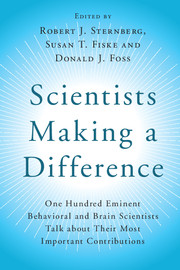 Scientists Making a Difference
Scientists Making a Difference Book contents
- Frontmatter
- Contents
- List of Contributors
- Foreword: Making a Creative Difference = Person × Environment
- Preface
- Part I Introduction
- Part II Biological Bases of Psychology: Genes, Brain, and Beyond
- Part III Cognition: Getting Information from the World and Dealing with It
- Section A Attention and Perception
- Section B Learning and Memory
- Section C Complex Processes
- 34 A Unified Theory of Mind
- 35 Multiple Intelligences: Prelude, Theory, and Aftermath
- 36 Heuristics and Biases
- 37 Comprehension
- 38 The Perception of Risk
- 39 What Does It Mean to Be Intelligent?
- Part IV Development: How We Change Over Time
- Part V Motivation and Emotion: How We Feel and What We Do
- Part VI Social and Personality Processes: Who We Are and How We Interact
- Part VII Clinical and Health Psychology: Making Lives Better
- Part VIII Conclusion
- Afterword: Doing Psychology 24×7 and Why It Matters
- Index
- References
35 - Multiple Intelligences: Prelude, Theory, and Aftermath
from Section C - Complex Processes
Published online by Cambridge University Press: 05 August 2016
- Frontmatter
- Contents
- List of Contributors
- Foreword: Making a Creative Difference = Person × Environment
- Preface
- Part I Introduction
- Part II Biological Bases of Psychology: Genes, Brain, and Beyond
- Part III Cognition: Getting Information from the World and Dealing with It
- Section A Attention and Perception
- Section B Learning and Memory
- Section C Complex Processes
- 34 A Unified Theory of Mind
- 35 Multiple Intelligences: Prelude, Theory, and Aftermath
- 36 Heuristics and Biases
- 37 Comprehension
- 38 The Perception of Risk
- 39 What Does It Mean to Be Intelligent?
- Part IV Development: How We Change Over Time
- Part V Motivation and Emotion: How We Feel and What We Do
- Part VI Social and Personality Processes: Who We Are and How We Interact
- Part VII Clinical and Health Psychology: Making Lives Better
- Part VIII Conclusion
- Afterword: Doing Psychology 24×7 and Why It Matters
- Index
- References
Summary
Beyond question, the contribution to psychology for which I am best known is the theory of multiple intelligences. Before turning to that theory, it's important for me to describe my own background and the ways in which I think about the scholarly work that I carry out.
Before going to graduate school in developmental psychology, I had never taken a conventional psychology course. My background was in the broader social sciences, with an emphasis on interpretive social science rather than on experiments or quantitative work. When I began to study developmental psychology, I became fascinated by the work of the great Swiss psychologist Jean Piaget. Piaget considered scientific thinking as the high point of cognitive development. That's one plausible “end state.” But, as a trained musician and a lover of the arts, I wondered how one would construe human development – including cognitive development – if one were to think of “artistic thinking” as the apogee of human cognition.
As a budding scholar interested in the arts – an interest shared at the time by few psychologists – I was uncertain about my next career step. Uncertainty gave way to an unexpected career move when I encountered the literature on damage to the human brain. Without minimizing the tragedy of stroke, trauma, or tumor, any brain damage constitutes an “experiment in nature.” One identifies the type and site of the lesion and ascertains how that lesion affects human cognition. As just one example, damage to the language areas spares the capacity to sing, while damage to the musical areas leaves linguistic capacities unaffected.
I had found a way to study human cognition in the arts. And indeed, for the next twenty years I divided my research time between the Boston Veterans Administration Medical Center, where I studied the effects on artistry of various kinds of brain damage, and Harvard Project Zero, a research center of which I was a founding member, where I studied the development in children of artistic capacities.
In studying the effects of brain damage, I made what I consider to be my most important discovery in scientific psychology. The classical teaching is that, in right-handed persons, language is housed in the left hemisphere; brain damage there produces aphasia (language disability). Neurologists had occasionally observed that, in right-handed persons, damage to the right side of the brain produces an odd set of symptoms.
- Type
- Chapter
- Information
- Scientists Making a DifferenceOne Hundred Eminent Behavioral and Brain Scientists Talk about Their Most Important Contributions, pp. 167 - 170Publisher: Cambridge University PressPrint publication year: 2016
References
- 5
- Cited by
